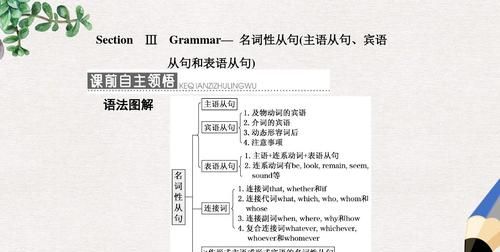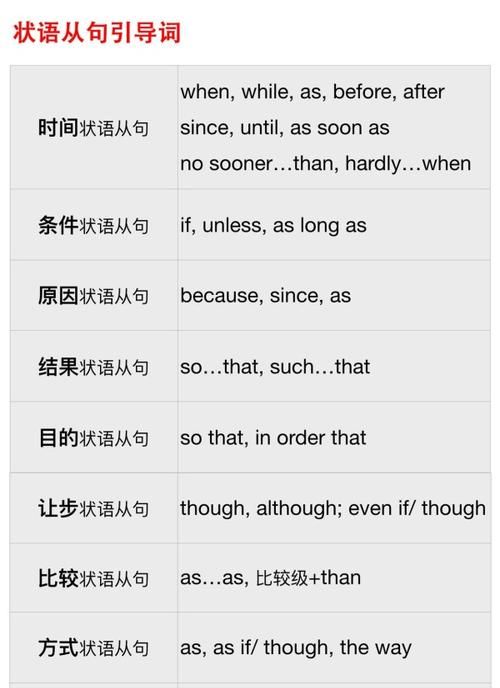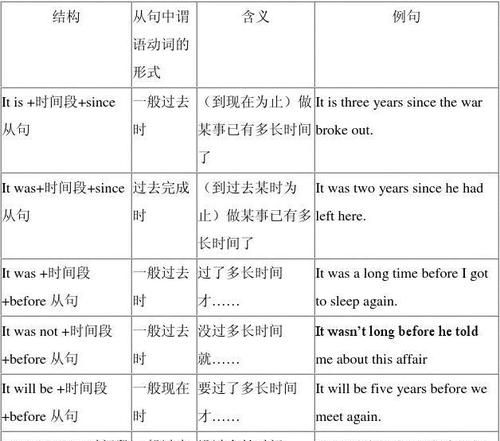本文目录
怎么区分各种从句
英语中总共有六大从句,区分方法,用法,及例子如下:
1.主语从句
1)主语从句可直接位于主语的位置,如果从句较长,谓语又较短,可用it作形式主语,而将从句放在句末.常见的句型有:
*It is a fact\a pity\a question\good news that...
*It seems\appears\happened\has turned out that...
*It is clear\important\likely\possible that...
*It is said\reported\estimated\has been proved that...
It is said that comic books create a connection between people of the same generation.
It seems that the performance is very useful.
2)what引导的主语从句表示“...的东西时”,一般不用it作形式主语.
What we lack is experience.
3)what,who,when,why,whether等词含有各自的疑问意义,但它们引导的主语从句,都用陈述语序.
How the plan is to be carried out should be discussed again.
I did know why I felt like crying.
2.宾语从句
1)宾语从句可位于及物动词、介词和某些形容词后.连词that常可省略.介词后一般接疑问词引导的宾语从句.in that(因为),except that(除了),but that(只是)已构成固定搭配,其他介词后一般不接that引导的宾语从句.
*I promised that I would change the situation.
*All this is different from what American young people would say about friendship.
*He is certain that watching so much television is not good for children.
*This article is well-written except that it is a bit too long.
2)宾语从句后如有宾补,要用形式宾语it来代替,而把宾语从句移至宾补之后.
He has made it clear that he would not change his mind.
3)在think,believe,suppose,expect等动词后的宾语从句中,如果谓语是否定的,一般将否定词移至主句谓语上,宾语从句则变成肯定形式.
He didn't think that the money was well spent.
3.表语从句
表语从句出现在结构为“主语+系动词+表语从句”的句子中.表语从句除可用that,what,when,why,whether,how等引导外,还可由because,as if(though)等引导.that常可省略.如主句主语为reason,只能用that引导表语从句,不可用because.
Perhaps the most important thing to remember is that there is no one common type of life in America.
The reason why so many people died there is that there were not enough food supplies.
It looks as if successful international cultural communication will make the world smaller.
4.同位语从句
同位语从句用于对前面出现的名词作进一步说明,一般用连词that引导,由于先行名词的意义不同,也可用whether,who,when,where,what,why,how等引导.常见的先行名词有fact,idea,belief,news,hope,conclusion,evidence,suggestion,order,problem,report,decision.有时由于谓语较短,将同位语从句位于谓语之后.
She finally made the decision that she would join the fashion show.
I had no idea how many books I could borrow at a time.
The news came that their team had won the championship.
5.定语从句
定语从句所修饰的先行词可以是名词或代词,也可以是一个句子.定语从句通常位于先行词之后,由关系代词或关系副词引导.
*限制性定语从句
限制性定语从句修饰先行词,对先行词起修饰作用,紧接先行词之后,无逗号,若省去,原句意思不完整.引导定语从句的关系代词有who,whom,whose,which,that等.who,whom,whose用于指人,whose有时也可指物,相当于of which;which用于指物;that既可指人也可指物,但只用于限制性定语从句中.关系代词除了引导定语从句,替代先行词外,还在从句中担任主语、宾语、定语等.
The computers and cables which make up the Internet are owned by people and organizations.
Those who live alone or who are sick may have trouble in getting close to other people.
The girl whose parents died in an accident is living with her grandmother.
1)当先行词是all,anything,everything,something,nothing等不定代词或先行词前有first,last,any,few,much,some,no,only以及形容词最高级修饰时,只能用关系代词that引导从句.
That is all that I've heard from him.
He's the first person that I'm going to interview this afternoon.
2)关系代词的省略
在从句中作宾语的关系代词常可省略.关系代词紧跟介词,作介词宾语时不可用that,只可用which或whom引导从句,并且不可省略,但当介词位于宾语从句句末时,作为介词宾语的关系代词仍可用that,也可省略.
This is one of those things with which we have to put up.
This is one of those things (which\that) we have to put up with.
3)引导定语从句的关系副词有when,where,why等.关系副词在从句中作状语,意义上相当于一个“介词+which”的结构.
Even in comic books where(=in which) there are no words,the stories are fully expressed through the drawings.
No one knows the reason why(=for which) he was so angry that day.
5.定语从句
*非限制性定语从句
非限制性定语从句既可修饰先行词,也可修饰整个主句,起补充说明作用,与主句之间有逗号隔开,若省去,原句意思不受影响.不可用that引导非限制性定语从句.关系词不可省略.
Every object has a gravitational pull,which is rather like magnetism.
*“介词+which\whom\whose”引导的定语从句
“介词+which\whom\whose”可引导限制性定语从句,也可引导非限制性定语从句,该结构中介词的选择取决于从句谓语动词的固定搭配,或先行词的习惯搭配.
This is the computer on which he spent all his savings
It is written by a person with whom we are all familiar.
*as引导的定语从句
as引导的定语从句主要用于“such...as”及“the same...as”的结构中,代替先行词是人或物的名词.as引导非限制性定语从句时,代替整个主句,从句可位于主句之前、之后或中间.
These are not such problems as can be easily solved.(as代替先行词problems)
As is mentioned above,no single company or group can control what happens on the Internet.(as代替主语)
6.状语从句
*时间状语从句
引导时间状语从句的从属连词和词组有:
1)when,whenever,while,as,after,before,since,till,until,once等.
We have learnt quite a lot about it since we came here.
2)as soon as,hardly(scarcely)...when,no sooner...than,each(every) time,the moment,immediately(that)等.
As soon as I sent an e-mail message,I received positive responses.
The moment he heard the good news,he jumped with joy.
*地点状语从句
引导地点状语从句的连词是where,wherever.
Wherever she went,she took her little daughter with her.
*原因、结果和目的状语从句
1)引导原因状语从句的从属连词有:because,as,since,now(that),seeing that,considering that,in that等.
Considering that he is a freshman,we must say he is doing well.
2)引导结果状语从句的连词有:so...that,such...that
,so that,that,so等.
Mickey Mouse is so attractive that the children are reluctant to leave.
3)引导目的状语从句的连词有:so that,in order that,for fear that,lest等,从句常使用may,might,can,could,would等情态动词.
We got up early this morning so that we could catch the first bus to the railway station.
*条件和让步状语从句
1)引导条件状语从句的连词和词组有if,unless,as(so) long as,on condition that,in case,provided(providing) that,supposing等.
As long as you have the right equipment,you can use a telephone line to transmit computer data.
2)引导让步状语从句的连词和词组有though,although,whether,even though,even if,no matter what(when,how...),whatever(whenever,wherever,however.)等.though,even if等引导状语从句可转换成含有as的部分倒装结构,具有强调意义.其结构为“形容词(副词、动词、名词)+as+主语+谓语”.
No matter what you may say,I would not change my mind.
Young as he is,he is quite experienced in this work.(=though he is young)
Child as he is,he can speak English fluently.(=though he is a child)
*方式状语从句
引导方式状语从句的连词有as,just as,as if,as though等.as if,as though引导的状语从句中,谓语动词常用虚拟语气,表示与事实相反.
The young man made the experiment just as the teacher had taught him.
Everything went on as usual as if nothing had happened.

如何分析英语从句
从句是相对于主句而言的,即它是从属于某一个主句,而不能单独作一个句子。在英语中,主要有三大从句,即名词性从句(包括主语从句,宾语从句,表语从句,同位语从句)、形容词性从句(即定语从句)、副词性从句(即状语从句,包括时间、条件、结果、目的、原因、让步、地点、方式等)。
主语从句用作主语,如::That
the
earth
is
round
is
true.
地球为圆的是真实的。
宾语从句用作宾语。如:Do
you
know
where
he
lives?
表语从句用作表语,如:
My
opinion
is
that
you
should
not
go
alone.
我的意见是你不应单独前往。
同位语从句用于解释说明前面的名词。如:
The
fact
that
the
earth
is
round
is
true.
地球是圆的的事实是真实的。(that从句用于解释说明the
fact)
定语从句相当于一个形容词,用于修饰前面的名词。如:
The
student
who
answered
the
question
was
John.
回答问题的学生是John.
状语从句相当于一个副词,如:
When
it
rains,
I
usually
go
to
school
by
bus.
天下雨时,我通常坐公共汽车上学。(时间状语)
If
he
comes
tomorrow,
you
will
see
him.
如果他明天来,你就可以看见他。(if
引导的条件状语从句,其结构为:if
+状语从句,+主句)。要注意在状语从句中有一个规则是“主将从现”,即主句是将来时,则从句要用一般现在时表示将来。
主句和从句的划分方法是相同的。句子的成分从谓语动词处来划分比较容易。谓语动词前面的部分是主语,后面常接宾语,修饰谓语动词的是状语,修饰主语、宾语的是定语,若谓语是系动词,则系动词后的部分是表语。如:
I
am
a
teacher.
其中,I
是主语,am是谓语,a
teacher
是表语。
He
likes
playing
football
very
mucy.
其中,he是主语,likes是谓语,playing
football是宾语,very
much是状语。

英语中如何判断状语
区分英语从句的“小窍门”
根据英语从句在句子中的句法作用,从句可分为三类:名词性从句,形容词性从句和副词性从句.通过对引导从句的各种引导词进行观察,我们不难发现,有的从句可以直接从引导词的形式和意义上来区分.如:Though the old man is over seventy,he still sees well and hears well.我们一读此句,就可以认定,由Though引导的从句是一个让步状语从句.因为though只能引导让步状语从句,不能引导其它从句,但是有些引导词却能引导多种从句.如引导词when:既可以引导时间状语从句又可以引导定语从句,还可以引导名词性从句.此外,象that,where等,三类从句均可引导;who既可引导定语从句,又可引导名词性从句;so that 即可引导目的状语从句,又可引导结果状语从句……因此,这些形同义不同的引导词给我们理解、掌握、运用各种从句带来了很大困难.另外,搞不清楚从句在句子中所起的作用,就不能正确理解原文.那么,怎样正确区分各种形同义不同的引导词引导的从句呢?
1、 分析句子结构以区虽从句的种类
2、 分析引导词的句法作用以区别从句的种类
区分that引导的是同位语从句还是定语从句的方法是,看that在从句中是否充当句子成分,若that在从句中不充当任何成分,则为同位语从句;若that在从句中充当主语或宾语,则为定语从句.
3、 根据被修饰词来判断从句的种类
定语从句常常修饰一些具有实际意义的名词,如:the film;the student;the book;a house等等.而同位语从句常常修饰一些表示抽象概念的名词,如fact、idea、promise、truth等,用来说明这些名词所表示的具体内容.状语从句在句子中常用来修饰谓语动词.
4、 根据从句前词的词性来判断从句的种类
宾语从句分两种:动词的宾语从句、介词的宾语从句.宾语从句前肯定是动词或介词.定语从句是用来修饰名词或代词的,所以其前一定是一个名词或代词.
5、 根据上下文意义和结构形式上区分从句的种类
①根据上下文意义判断.“以便……”表示目的,是目的状语从句,“以致于……”,“结果……”表示结果,是结果状语从句.
②从结构形式上来分辨.so that前有逗号,为结果状语从句,反之,则为目的状语从句.

英语中从句分为哪些是怎么划分的呢
从句是相对于主句而言的,即它是从属于某一个主句,而不能单独作一个句子.在英语中,主要有三大从句,即名词性从句(包括主语从句,宾语从句,表语从句,同位语从句)、形容词性从句(即定语从句)、副词性从句(即状语从句,包括时间、条件、结果、目的、原因、让步、地点、方式等).
主语从句用作主语,如::
That the earth is round is true.地球为圆的是真实的.
宾语从句用作宾语.如:
Do you know where he lives?
表语从句用作表语,如:
My opinion is that you should not go alone.我的意见是你不应单独前往.
同位语从句用于解释说明前面的名词.如:
The fact that the earth is round is true.地球是圆的的事实是真实的.(that从句用于解释说明the fact)
定语从句相当于一个形容词,用于修饰前面的名词.如:
The student who answered the question was John.回答问题的学生是John.
状语从句相当于一个副词,如:
When it rains,I usually go to school by bus.天下雨时,我通常坐公共汽车上学.(时间状语)
If he comes tomorrow,you will see him.如果他明天来,你就可以看见他.(if 引导的条件状语从句,其结构为:if +状语从句,+主句).要注意在状语从句中有一个规则是“主将从现”,即主句是将来时,则从句要用一般现在时表示将来.
主句和从句的划分方法是相同的.句子的成分从谓语动词处来划分比较容易.谓语动词前面的部分是主语,后面常接宾语,修饰谓语动词的是状语,修饰主语、宾语的是定语,若谓语是系动词,则系动词后的部分是表语.如:
I am a teacher.其中,I 是主语,am是谓语,a teacher 是表语.
He likes playing football very mucy.其中,he是主语,likes是谓语,playing football是宾语,very much是状语.
英语中8种从句介绍
1定语从句
2时间状语从句
3地点状语从句
4条件状语从句
5同位语从句
6表语从句
7宾语从句
8主语从句
名词性从句:在句子中起名词作用的句子叫名词从句 (Noun Clauses).名词从句的功能相当于名词词组,它在复合句中能担任主语、宾语、表语、同位语、介词宾语等,因此根据它在句中不同的语法功能,名词从句又可分别称为主语从句、宾语从句、表语从句和同位语从句.
引导名词性从句的连接词
引导名词性从句的连接词可分为三类:
连接词:that,whether,if 不充当从句的任何成分)
连接代词:what,whatever,who,whoever,whom,
whose,which.
连接副词:when,where,how,why
不可省略的连词:
1.介词后的连词
2.引导主语从句和同位语从句的连词不可省略.
That she was chosen made us very happy.
We heard the news that our team had won.
比较:whether与if 均为"是否"的意思.但在下列情况下,whether 不能被if 取代:
1.whether引导主语从句并在句首
2.引导表语从句
3.whether从句作介词宾语
4.从句后有"or not"
Whether he will come is not clear.
大部分连接词引导的主语从句都可以置于句末,用 it充当形式主语.
It is not important who will go.
It is still unknown which team will win the match.
)由从属连词that引导的从句叫做名词性that-从句.That只起连接主句和从句的作用,在从句中不担任任何成分,本身也没有词义.名词性that-从句在句中能充当主 语、宾语、表语、同位语和形容词宾语,例如:
主语:That he is still alive is sheer luck.他还活着全靠运气.
宾语:John said that he was leaving for London on Wednesday.约翰说他星期三要到伦敦去.
表语:The fact is that he has not been seen recently.事实是近来谁也没有见过他.
同位语:The fact that he has not been seen recently disturbs everyone in his office.
近来谁也没有见过他,这一事实令办公室所有的人不安.
形容词宾语:I am glad that you are satisfied with your job.
你对工作满意我感到很高兴.
2)That- 从句作主语通常用it作先行词,而将that-从句置于句末,例如:
It is quite clear that the whole project is doomed to failure.很清楚,整个计划注定要失败.
It's a pity that you should have to leave.你非走不可真是件憾事
.

以上就是关于英语怎么区分各种从句,怎么区分各种从句的全部内容,以及英语怎么区分各种从句 的相关内容,希望能够帮到您。

